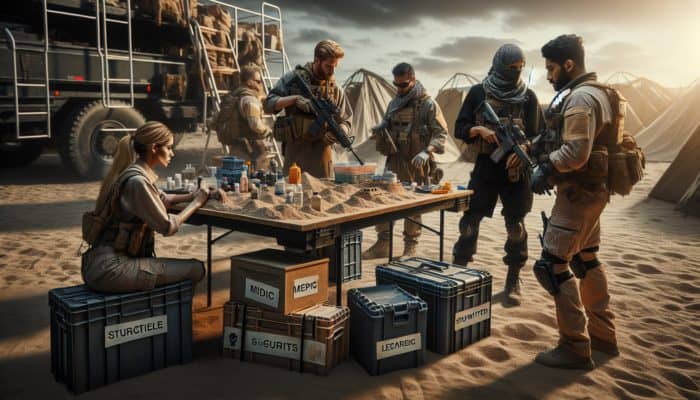Create a Strong Communication Network to Enhance Your Preparedness Skills
Foster Trust-Based Relationships in Your Preparedness Community

Building a robust network of trustworthy contacts is crucial for mastering effective prepper communication skills. This network serves as an essential lifeline for information and support during emergencies, providing you with access to vital resources when you need them the most. Start by identifying individuals in your community who align with your preparedness goals or possess valuable skills, such as medical professionals, engineers, or experienced outdoor enthusiasts. By establishing connections with these individuals, you not only expand your resource network but also strengthen your support system, enabling you to tackle unexpected challenges more effectively.
Engaging with local community groups or joining online forums can significantly enhance these connections. Make it a point to actively participate in discussions, attend relevant meetups, or engage in workshops focused on emergency preparedness. By nurturing these relationships, you ensure that you can rely on your network when every second counts. Additionally, creating a routine check-in system with your contacts is vital. This way, everyone stays informed about preparedness efforts, allowing for the seamless exchange of critical information. Regular interaction helps solidify the bonds within your network, thereby enhancing its overall effectiveness during crises.
Consider implementing a structured point of contact system, ensuring that everyone knows whom to reach out to in various scenarios. Designating group leaders or assigning roles based on expertise can facilitate smoother communication during emergencies. Remember, the strength of your network is not solely determined by the number of contacts but by the trust and reliability that has been established among its members. By nurturing these relationships, you elevate your overall prepper communication skills and foster a more coordinated response during emergencies.
Unlock the Full Potential of Amateur Radio for Crisis Communication
Amateur radio, commonly known as ham radio, is an indispensable communication tool when conventional methods fail. Its ability to operate independently of the internet allows you to send messages across vast distances, making it crucial in emergencies. To effectively utilise amateur radio, start by obtaining the necessary licenses, which may vary by region but generally require a foundational understanding of basic radio operations and relevant regulations. This essential knowledge empowers you to maximise the benefits of this powerful communication tool.
Once you have obtained your license, invest in a quality radio transceiver and take the time to familiarize yourself with its operation. Gain a comprehensive understanding of the various frequencies and communication modes available, including voice, digital, and Morse code. Joining an amateur radio club can provide invaluable hands-on experience and access to seasoned mentors who can guide you. Regular practice is key; engage in local nets or participate in emergency drills to refine your skills and prepare for real-world scenarios.
Furthermore, it’s advisable to develop a detailed emergency communication plan that incorporates radio protocols tailored for different situations. This plan should clearly delineate procedures for initiating calls, relaying messages, and maintaining contact under challenging conditions. Understanding the intricacies of radio communication, such as using phonetic alphabets and clear speaking techniques, enhances the clarity of your messages. This ensures that critical information is communicated effectively, thereby improving your overall communication efforts.
Develop a Comprehensive Communication Strategy for Emergency Situations
Having a well-structured communication plan is essential for ensuring effective coordination during emergencies. Begin by identifying the specific types of emergencies that are likely to occur in your area, such as natural disasters like earthquakes or human-made crises. Based on these potential scenarios, outline targeted communication strategies designed to address the unique challenges presented by each situation.
Involve all relevant stakeholders in this planning process, including family members, community groups, and local organisations. By incorporating diverse perspectives, you can develop a more comprehensive approach that meets various communication needs. Clearly document the plan, outlining individual roles, responsibilities, and preferred communication methods, whether face-to-face, radio, or digital. This clarity becomes invaluable when swift decisions and clear communication are paramount in high-stress situations.
Regularly review and update your communication plan to reflect changes in technology, personnel, or local conditions. Conduct drills to ensure that everyone is familiar with their roles and can implement the plan effectively. This proactive approach builds confidence and reduces chaos during emergencies, enhancing your overall prepper communication skills and ensuring that your group operates smoothly under pressure.
Sharpen Your Non-Verbal Communication Skills for Improved Interactions

Enhance Your Ability to Interpret Body Language for Better Communication
Non-verbal communication is a critical aspect of how messages are conveyed, especially during high-stress situations where verbal expression may fall short. Understanding body language can provide valuable insights into the feelings and intentions of others, facilitating more effective interactions. Begin by observing common body language cues, such as posture, gestures, and facial expressions. For instance, crossed arms may suggest defensiveness, while an open stance indicates receptiveness and a willingness to engage.
In a crisis, being attuned to the non-verbal signals of those around you can help you assess their emotional state and respond appropriately. This skill becomes particularly critical when verbal communication is hindered by noise or urgency. By honing your ability to interpret body language, you can foster stronger connections and enhance group cohesion, ensuring that everyone feels acknowledged and understood during challenging moments.
Practice your observational skills during everyday interactions. Pay close attention to how individuals react in various situations and how their body language correlates with their spoken words. This heightened awareness can translate into improved communication during emergencies, where decoding unspoken cues can be the difference between confusion and clarity. Cultivating this skill will enhance your overall ability to communicate effectively under pressure.
Establish Effective Hand Signals for Silent Communication
Hand signals become invaluable tools for conveying messages swiftly when verbal communication is not feasible. Developing a set of universally understood hand signals can streamline silent communication among group members. Start by establishing basic signals for common commands, such as “stop,” “go,” or “help,” ensuring that everyone comprehends their meanings to prevent miscommunication.
When designing your hand signals, strive for simplicity and intuitiveness to minimise the risk of misunderstandings. Conduct regular training sessions with your group to practice these signals in various scenarios, particularly in situations where silence is crucial, such as during a discreet evacuation or while navigating hazardous areas. This practice will significantly enhance your group's communication capabilities in critical situations.
Moreover, consider incorporating visual aids—like charts or diagrams depicting the signals and their meanings. These can serve as quick reference guides during emergencies, ensuring everyone is aligned. The more familiar everyone becomes with the hand signals, the more effectively your group can maintain communication without drawing attention, ultimately enhancing your overall preparedness.
Use Facial Expressions to Communicate Emotions Effectively

Facial expressions are powerful nonverbal communication tools that can convey a wide range of emotions, from fear to determination. Learning to interpret and effectively use facial expressions can significantly enhance communication during crises. Start by studying common expressions associated with specific emotions and practice conveying those emotions authentically to ensure your message resonates with others.
In a group setting, being attentive to others' facial expressions can provide crucial insights into their feelings and mental states. For instance, recognising signs of fear or anxiety can prompt you to offer reassurance or support. Conversely, displaying calm and determined facial expressions can instill confidence in others during tense situations, fostering a sense of security and unity within your group.
Engaging in role-playing exercises can assist you and your group in practising the effective use of facial expressions. Create scenarios where non-verbal communication is crucial, and experiment with different expressions to observe their impact on group morale and clarity of communication. By mastering the art of facial expressions, your prepper communication skills will become more nuanced and effective, enabling you to navigate crises with greater ease and confidence.
Optimize Your Verbal Communication Techniques for Maximum Clarity
Deliver Clear and Concise Messages in High-Pressure Situations
In emergencies, the ability to deliver clear and concise messages is of utmost importance. Individuals may be under considerable stress or racing against time, making it essential to convey information that is straightforward and easy to comprehend. Begin by selecting simple language that avoids jargon or overly complex terminology. This approach ensures that everyone, regardless of their background or training, understands the message without confusion, thereby enhancing communication effectiveness.
When relaying critical information, focus on the essential points. Use bullet points or numbered lists to break down information into manageable segments. For example, during a crisis, you could communicate evacuation routes or safety protocols using clear language and a logical progression, ensuring clarity amid chaos. This strategy not only aids in comprehension but also promotes quick decision-making in high-pressure scenarios.
Repetition can further enhance understanding; reiterating key messages reinforces their significance. Encourage feedback by asking questions or seeking confirmation of understanding. This practice clarifies the information shared and fosters engagement, ensuring that your group is actively involved in the communication process. By prioritising clarity and engagement, you strengthen the effectiveness of your communication strategies during emergencies.
Develop Active Listening Skills to Enhance Communication
Active listening is a vital component of effective communication, especially in high-stakes situations. It involves not just hearing words but fully engaging with the speaker to grasp their message and emotions. Practising active listening can significantly elevate your prepper communication skills. Start by maintaining eye contact and providing verbal affirmations, such as nodding or saying “I see,” to signal your attentiveness and encourage the speaker to share their thoughts openly.
Avoid interrupting the speaker; allow them to express their thoughts completely before responding. This demonstrates respect and enables you to gather all necessary information for your response. After the speaker has finished, summarise what you've heard to confirm your understanding and clear up any misconceptions. This practice not only improves clarity but also builds trust within your group.
Incorporating active listening techniques can foster an environment where open communication is encouraged. This is particularly critical during emergencies when misunderstandings can have serious consequences. Regularly practising these skills in everyday interactions will enhance your ability to listen effectively when it matters most, ultimately improving your group’s overall communication dynamics.
Manage Stress to Improve Communication Effectiveness
Communication in high-pressure situations can be fraught with stress and anxiety, which can impede clarity and effectiveness. Managing your emotions and maintaining composure during conversations is vital for effective communication. Start by practising deep breathing techniques to calm your mind and body before engaging in discussions, particularly those involving critical information or difficult choices. This simple strategy can help you approach conversations with a clearer mindset.
Being aware of your emotional state will help you control your reactions and respond thoughtfully rather than impulsively. Strive to maintain a steady tone of voice and open body language, as this influences the overall atmosphere of the conversation and helps to put others at ease. By modelling calm behaviour, you can encourage others to respond positively, fostering a more productive dialogue.
Encourage open dialogue within your group, allowing individuals to express their feelings and concerns. This open communication can help mitigate stress and create a supportive environment. Regularly engaging in group stress management exercises can strengthen your ability to communicate effectively under pressure, enhancing your overall communication skills and resilience in challenging situations.
Implement Digital Communication Strategies to Enhance Modern Preparedness
Select Secure Messaging Platforms for Confidential Communication
In our increasingly digital landscape, where security is paramount, selecting secure messaging platforms is essential for confidential communication. Investigate various applications that offer end-to-end encryption and robust privacy features. Popular platforms like Signal and Telegram provide strong security measures, ensuring that your messages remain private and protected from interference by malicious actors.
When implementing these platforms, ensure that all group members are well-acquainted with their functionalities. Conduct training sessions to navigate the app's features, such as creating groups, securely sending files, or using voice notes. Emphasise the importance of maintaining strong passwords and activating two-factor authentication for enhanced security. By prioritising security in your digital communications, you can safeguard sensitive information and maintain trust within your network.
Regularly review your communication protocols, especially when sharing sensitive information. Stay informed about security threats and best practices to protect your communications. By cultivating a culture of digital security awareness, you strengthen your communication network's resilience against potential breaches, ensuring that your group can communicate effectively and securely during emergencies.
Leverage Social Media for Rapid Information Sharing During Crises
Social media can serve as an effective tool for gathering and disseminating information during emergencies. Platforms like Twitter and Facebook can provide real-time updates and facilitate rapid sharing of critical information. However, it’s important to navigate social media cautiously, as misinformation can spread quickly and undermine your communication efforts.
Establish clear guidelines for using social media within your group. Identify trustworthy sources of information and verify any updates before sharing them. Consider creating a dedicated group or page to centralise information sharing, making it easier for members to stay informed. This approach not only streamlines communication but also boosts the reliability of shared information.
Utilising relevant hashtags related to your location or situation can help increase visibility and engagement with your posts. Encourage group members to share information, resources, and support through these platforms, fostering community even in challenging times. By responsibly harnessing the power of social media, you can significantly enhance your group's communication capabilities during crises and build a supportive network.
Protect Your Digital Privacy in Communication
As our reliance on digital communication increases, protecting your privacy has become more critical than ever. Start by implementing basic cybersecurity practices, such as using strong and unique passwords for each platform, employing password managers, and regularly updating your software to guard against vulnerabilities. These simple measures can significantly enhance your security posture and protect sensitive information.
In addition to technical safeguards, it’s crucial to educate your group members about the importance of digital hygiene. Discuss the risks associated with sharing sensitive information online and encourage them to think critically about the content they post or share. Regularly review your communication protocols to adapt to emerging threats and ensure everyone remains vigilant. This proactive approach will help maintain the integrity of your communications and build trust among group members.
Consider using Virtual Private Networks (VPNs) to protect your data from prying eyes when communicating over public Wi-Fi networks. By prioritising digital privacy, you can maintain the confidentiality of your communications and enhance your overall preparedness for emergencies, ensuring that your group is equipped to handle any situation.
Utilise Email Encryption Techniques for Secure Communication
Email remains a widely used communication tool, yet its security is often compromised. Learning to encrypt emails is essential for protecting your communications against interception and unauthorised access. Tools like PGP (Pretty Good Privacy) and S/MIME (Secure/Multipurpose Internet Mail Extensions) provide robust encryption options that ensure only intended recipients can access your messages, greatly enhancing the security of your email communications.
Begin by familiarising yourself with these encryption methods and selecting an appropriate tool. Many email clients offer built-in encryption features, while standalone applications can provide additional layers of security. Conduct training sessions to educate your group on how to use these tools effectively, ensuring everyone understands the importance of safeguarding sensitive information.
Regularly remind your group of the necessity of encrypting sensitive information shared through email. Reinforcing these practices will cultivate a culture of security consciousness, ensuring that your communications remain confidential and secure. By mastering email encryption, you enhance your prepper communication skills and protect vital information during emergencies, thereby improving your group's overall readiness.
Facilitate Effective Communication in Diverse Groups
Overcoming Language Barriers in Multilingual Teams
Communication within diverse groups can present challenges, particularly when language barriers exist. To promote effective interaction, consider employing translation apps or tools that facilitate real-time communication between individuals who speak different languages. Applications like Google Translate can help bridge the gap, enabling smoother exchanges of information and reducing the likelihood of misunderstandings.
Encouraging multilingual group members to share their language skills is also advantageous. Establish a buddy system where individuals pair up with someone who speaks a different language, creating opportunities for mutual learning and support. This approach can enhance overall group cohesion and understanding, particularly in high-stress situations where clear communication is crucial.
Cultural sensitivity plays a vital role in these interactions. Understanding the nuances of communication styles across cultures can improve your group’s dynamics. Regularly discuss cultural differences and encourage open dialogue about language preferences and communication needs. Embracing diversity will fortify your group’s resilience and adaptability, ultimately elevating your preparedness efforts.
Enhance Communication Through Cultural Sensitivity Awareness
Effective communication in diverse groups necessitates an awareness of cultural sensitivity. Different cultures possess unique norms and practices regarding communication, and respecting these differences is essential for fostering collaboration. Start by educating yourself and your group about various cultural communication styles and preferences, ensuring that everyone feels valued and understood within the group.
Encourage open discussions about cultural differences and how they can impact communication. This dialogue helps group members articulate their needs while fostering an understanding of others’ perspectives. Incorporating cultural competence training into your preparedness plans allows everyone to appreciate and respect the diverse backgrounds within the group. This training can significantly enhance overall communication dynamics and promote a sense of belonging among all members.
Being mindful of cultural sensitivities can also enrich non-verbal communication. For example, gestures acceptable in one culture may be deemed offensive in another. Encourage group members to share their experiences and insights to cultivate a more inclusive communication environment, thereby strengthening team dynamics and improving collaboration during emergencies.
Build Trust and Cohesion in Multicultural Teams
Trust serves as the foundation for effective communication, especially in diverse teams. Establishing trust among group members requires open dialogue, shared experiences, and mutual respect. Start by creating opportunities for team-building activities that promote collaboration and understanding. These experiences can help foster relationships and create a cohesive unit that is better prepared to handle crises.
Encourage transparency in communication by fostering an environment where individuals feel safe to voice their opinions and concerns. Regular check-ins can facilitate open discussions about group dynamics and address any emerging issues. By proactively addressing conflicts and misunderstandings, you can strengthen trust and cohesion within the group, ensuring that everyone feels valued and heard during critical moments.
Recognising and celebrating individual contributions can also enhance trust among team members. Highlight the unique skills and perspectives each person brings to the table, fostering a sense of belonging and appreciation. By prioritising trust-building efforts, you will enhance your group’s overall communication effectiveness and resilience during crises, ensuring that everyone works together harmoniously.
Implement Effective Crisis Communication Techniques
Addressing Misinformation During Emergencies
Misinformation can spread rapidly during crises, causing confusion and panic among individuals. Learning how to identify and counter misinformation is crucial for maintaining clear communication. Start by educating your group on common sources of misinformation, such as social media and unverified news outlets, to ensure they remain discerning consumers of information.
Encourage critical thinking and verification of information before sharing it. Establish a trusted source of information within your network, such as local authorities or expert organisations, to provide accurate updates during emergencies. This approach helps ensure your group receives reliable information, enabling informed decision-making in real-time.
When addressing misinformation, it is essential to communicate clearly and calmly. Provide concrete evidence and context to dispel falsehoods and encourage open discussions where group members can express their concerns. Maintaining transparency and fostering a culture of reliability within your group will help combat misinformation and strengthen overall communication, ensuring everyone is aligned during crises.
Coordinate Effectively with Emergency Services for Improved Outcomes
Effective communication with emergency services is vital during crises. Familiarise yourself with local emergency protocols and contact information for relevant services to ensure you are prepared to act swiftly. Develop a plan detailing how your group will coordinate with these services, designating specific individuals to act as liaisons during emergencies, which can streamline communication and enhance response efforts.
Training in communication protocols is crucial to ensure that all members understand how to contact emergency services. Conduct drills that simulate various crisis scenarios, allowing your group to practice their response and communication strategies in real time. This hands-on experience builds confidence and ensures everyone knows their roles during emergencies.
When communicating with emergency services, be clear and concise. Provide essential information such as location, type of emergency, and any pertinent details. This clarity will assist emergency responders in addressing the situation more effectively, enhancing your group's ability to navigate crises confidently and efficiently.
Maintain Morale and Cohesion Through Effective Communication
Upholding morale during crises is essential for effective communication and group cohesion. Regularly check in with group members to assess their emotional state and provide support. Open lines of communication enable individuals to express their feelings and concerns, fostering a sense of unity and shared purpose. This sense of togetherness can significantly bolster your group's resilience.
Encourage positive communication by sharing success stories and celebrating small victories, even in














